If you rewind time to mid-2011, you’ll find that this was when the first-ever set of Chromebooks seeped into the technological domain. ChromeOS didn’t take off with a lot of hype under its belt, given how it was pretty limited back in the day, but now that it’s more than a decade mature, Google has switched up the Chromebook scene outright monumentally.
Behold Chromebook Plus—no, this is not a subscription service, but rather a different class of upscaled Chromebooks that stand out from the rest of their counterparts in myriad ways, both on the hardware and software side. In recent times, Google has made several exciting announcements regarding this venture, and it’s certainly quite exciting.
In this guide, we’ll explore Chromebook Plus in detail, cover its pricing and prominent features, and talk a little about what the future of this effort holds for ChromeOS users. Let’s get started right away.
What is Chromebook Plus?
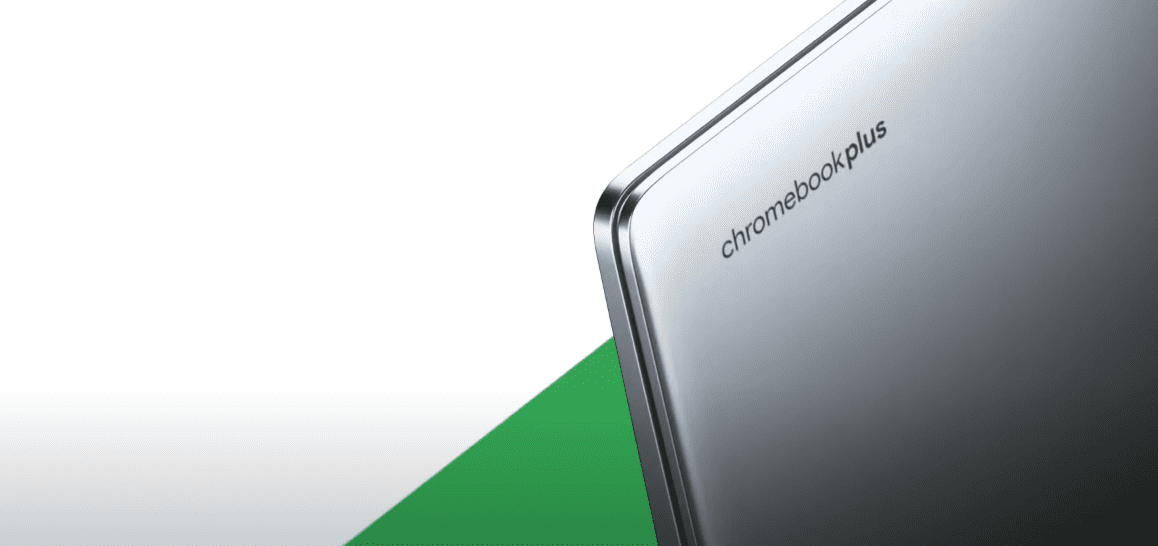
All-new Chromebook Plus branding on select devices
So, first off, what exactly is Chromebook Plus? Is it the name of a Chromebook loaded to the brim with hardware but overly costly on the same side? Yes, but no. Starting today, purchasing an entirely different category of Chromebooks with the “Chromebook Plus” branding on the chassis is possible.
There are two facets to the discussion here that users must be wary of going forward. Chromebook Plus brings enticing upgrades both on the hardware and software fronts, and if you’re a potential Chromebook buyer, you should stay up-to-speed on what to expect from this significant project.
The gist of it is that Chromebook Plus devices will now offer powerful hardware compared to their similarly-priced variants. Furthermore, as an operating system, ChromeOS will sport added features and capabilities on Chromebook Plus, which we’re about to dive deep into.
Everything new about Chromebook Plus that differs from regular Chromebooks
As the headline suggests, this section will comprehensively cover all the new stuff that Chromebook Plus offers compared to standard Chromebooks. Considering the number of novelties introduced, it will be a lengthy read, so sit tight.
Chromebook Plus devices come with twice the better hardware

Chromebook Plus primary features at a glance
Compared to the top-selling Chromebooks of 2022, Google offers two times the fundamental tech specs in Chromebook Plus. That means twice the processing power, twice the internal memory, and twice the storage. What the company is trying to achieve here — and we’re pretty sure it’s done that already — is create a new standard for Chromebooks.
This standard would categorize a select number of Chromebooks and label them fit to meet the needs of most users, if not all. The fact of the matter is, it’s not a rare scenario for someone to find themselves sifting through device after device, trying to get into the minutiae of the hardware, and then determining whether it’s the right unit for them.
Chromebook Plus is here to bridge that gap. Whenever you’re out shopping for a new device, you can instantly know that this device will get the majority of things done for you as soon as you spot the “Plus” branding on it. This level of convenience is a game-changer in the ChromeOS department, especially in the day and age we live in today, where an extended deluge of Chromebooks from different OEMs are available to purchase.
FPS display and 1080p webcam with TNR
Advancing on the hardware front, all Chromebook Plus devices will have at least an FHD (1920 x 1080p) display with an IPS (In-Plane Switching) panel for clearer resolution. And that’s just the bare minimum. Moreover, your Chromebook Plus will sport a 1080p webcam for sharper video conferencing, no matter the room’s lighting level.
We’ll expand on that more in the following subsection since it pertains to the software side more than the hardware. However, another feature that every Chromebook Plus webcam will offer is TNR, which is shorthand for Temporal Noise Reduction. It will serve as a category staple for all future Plus devices.
The added expanse of TNR will ensure that the picture quality has just the right amount of exposure and lighting needed to make the display quality truly pop off. Talk about the practicality of the affair weighing in for different use cases, whether you’re an educator or an enterprise representative relying on video calls frequently.
Natively enhanced video calls
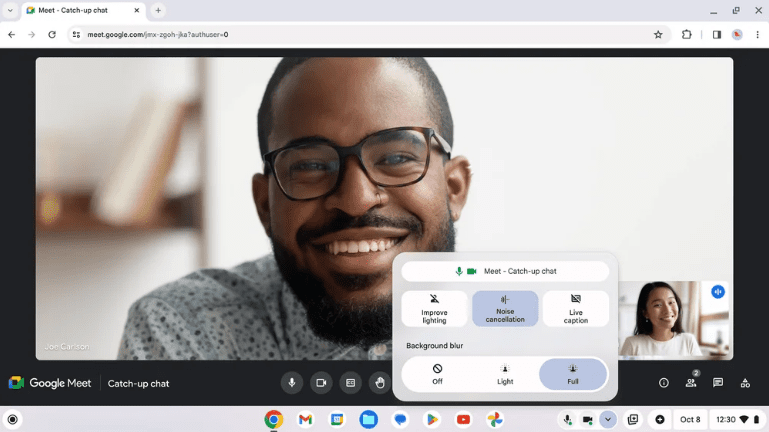
Enhanced video calling features on Chromebook Plus
Although there are ways to make video calls on Chromebook like a pro, Chromebook Plus is raising the bar immediately with its native conferencing enhancement features. Of course, the primary software it’ll utilize for its purpose is Google Meet, which is fast, reliable, and heavily involved with other Google products.
However, what makes things even more exciting is that you can use these features on any video calling software, whether WhatsApp, Skype, or even Zoom. This is because the video calling enhancement tools are baked into Chromebook Plus on an OS level and aren’t associated with a single application at all.
The features introduced as part of Chromebook Plus include lighting improvement, noise cancelation, live captions, and background blur. On the relevant devices, you’ll find the toolset on the ChromeOS shelf, located at the bottom of your Chromebook’s UI by default.
Powerful AI-fueled editing in Google Photos
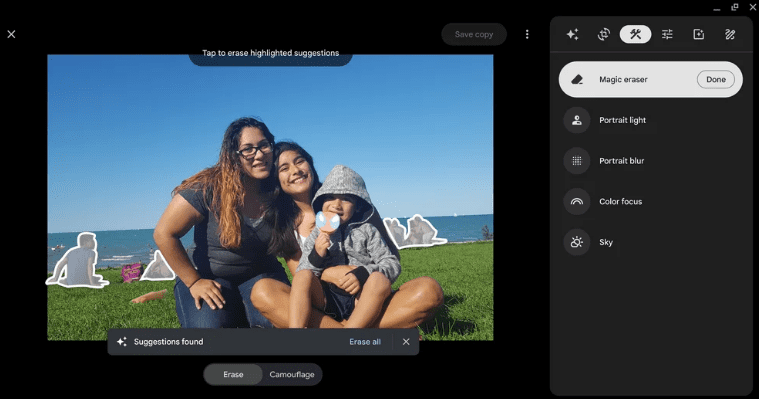
The Magic Eraser functionality in Google Photos on Chromebook Plus
Moving forward, Chromebook Plus will also host an AI-powered editing tool called Magic Eraser in Google Photos natively, allowing users to erase imperfections in their pictures effortlessly. Deleting unwanted elements in your photos prompts the Magic Eraser tool to make intuitive replacement suggestions for the area concerned afterward.
That’s not all; Google Photos on Chromebook Plus is set to sport additional functionality, namely revolving around other editing features, including HDR, which intelligently fixes your photo’s brightness, exposure, and contrast, not to mention portrait blur side by side.
New File Sync functionality
Currently, regular Chromebooks have the Google Drive subfolder embedded within the Files system app, which is pretty convenient for those looking to back up their locally stored content to the cloud occasionally. With Chromebook Plus, the developers have instilled automation in the equation.
Now, your Drive files get downloaded on your Chromebook automatically, so you can access them offline whenever and wherever. Just make sure that there’s enough space on the device. Judging from the 128 GB minimum storage capacity of Chromebook Plus devices, we doubt you’ll have to worry about the latter.
Adobe Photoshop and Adobe Express AI features
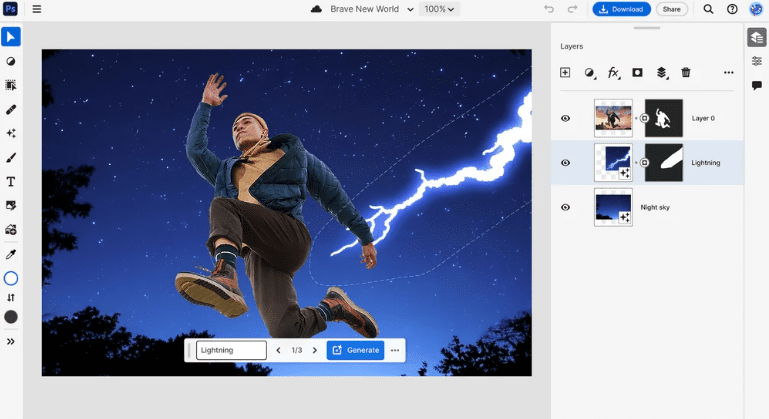
Adobe Photoshop on ChromeOS
It’s already known that Chromebook users can now work with Adobe Photoshop on the web. However, what Chromebook Plus strives to change on this front is the capacity to which users can operate Photoshop’s hefty feature set, thereby empowering you to work on “more graphically demanding projects” on ChromeOS.
Alongside Photoshop, Adobe Express Premium joins the foray as well, and along with it, the ability to employ the extensive capabilities of highly creative “generative AI” models. The latter seemingly takes editing to the next level and allows even the most beginner of graphic designers to professionally edit photos and create art designs for social media on the fly.
The best part is that Google lets new Chromebook Plus users try all that for free. With each new purchase of one of these newer devices, you’ll get three months of Adobe Photoshop and Express in the form of a no-cost trial run. Pretty alluring, wouldn’t you agree?
When can I get a Chromebook Plus device?
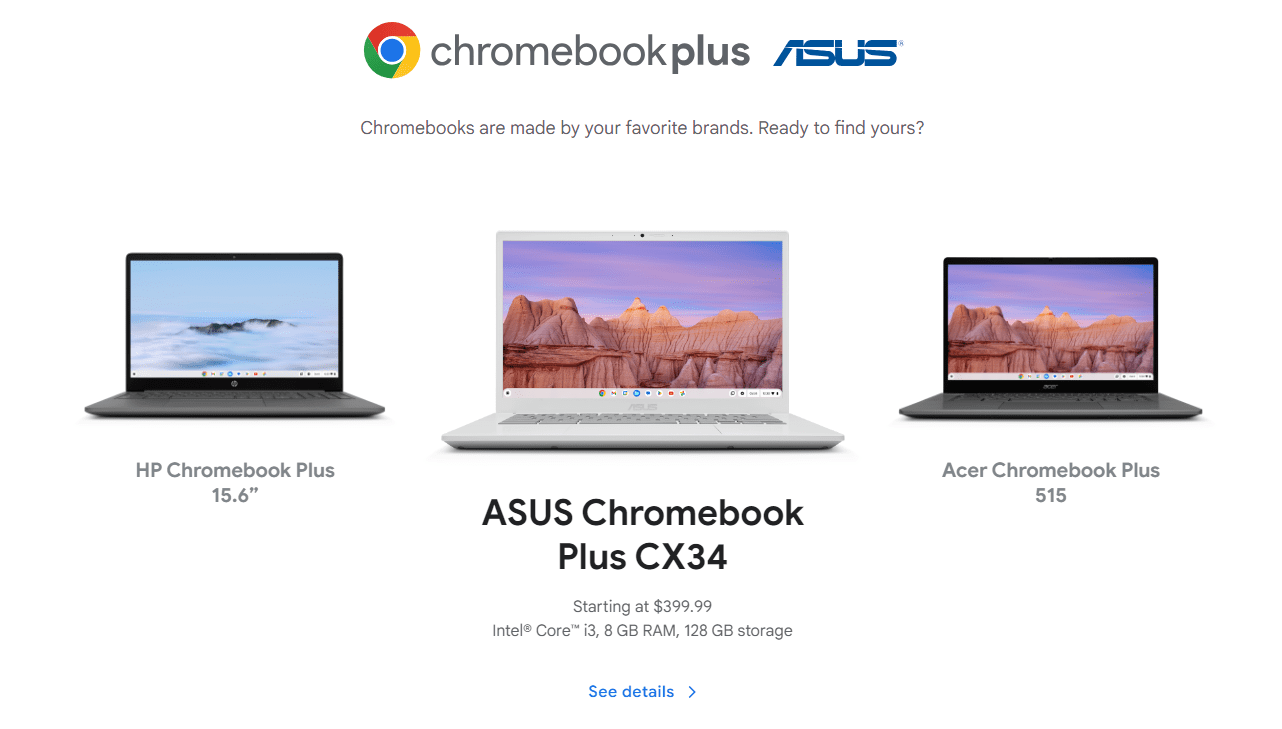
The new Asus Chromebook Plus CX34
Google has announced that starting October 8, all the latest Chromebook Plus devices will be released in the United States, making them up for purchase by everyone. The new Chromebook model category was made available a day later for European and Canadian citizens. The roll-out will continue across the rest of the world over the next few months or so.
As for where to purchase the new Chromebook Plus models, head over to your favorite major retailers, such as Best Buy, Walmart, Amazon, and Target, and you’ll find them available to be bought. The following subsection will cover all the Chromebook Plus devices that Google has launched.
All the new Chromebook Plus models announced
It turns out that Google has joined hands with the best Chromebook manufacturers, such as HP, Lenovo, Asus, and Acer, to bring out a whole fleet of Chromebook Plus devices for ChromeOS users. Currently, 8 devices — 2 from each OEM — have been launched. These are:
- Acer Chromebook Plus 515
- Acer Chromebook Plus 514
- Asus Chromebook Plus CM34 Flip
- Asus Chromebook Plus CX34
- HP Chromebook Plus 15.6″
- HP Chromebook Plus x360 14″
- Lenovo Flex 5i Chromebook Plus
- Lenovo Slim 3i Chromebook Plus
Can my existing device upgrade to the Chromebook Plus standard?
Yes, Google has outlined a transparent hardware requirement system for standard Chromebooks looking to get the Plus upgrade. If the Chromebook you have happens to come with the following tech specs, congratulations! You can enjoy all the added features of Chromebook Plus without purchasing a dedicated device.
Hardware and software specifications requirement for Chromebook Plus
Here are the specifications that your device needs to have to accomplish the task at hand:
- CPU: Intel Core i3 12th Gen or better, AMD Ryzen 3 7000 series or better
- RAM: 8GB or better
- Storage: 128 GB or better
- Webcam: 1080p or better with Temporal Noise Reduction
- Display: Full HD IPS or better
Some regular Chromebooks that make the cut for being upgradable to the Plus standard include the HP Dragonfly Chromebook Pro, Asus Vibe CX34 Flip, Frame Laptop Chromebook Edition, and Acer Chromebook Spin 714. Thankfully, Google has laid out an entire list of devices eligible for the ChromeOS Plus update.
That should make it easier to decide what devices you can purchase if you plan on trying out Chromebook Plus features in the future. Find all the compatible devices on this support page here. In addition, Google says that the upgrade will begin rolling out starting October 17 across the globe.
A note for the future
All of the announcements above are just the tip of the iceberg, as Google has revealed its plans to take things to the next level regarding the future of ChromeOS and ChromeOS Plus. The company is looking to introduce thoughtful AI features directly to Chromebooks, starting with a specialized writing assistant.
Google AI to work as an assistant for writing
Whether creating a Facebook post or a short email address to send to a colleague, using Google AI in the future will allow you to add humor to your writing with just a single click. You’ll give AI some instructions and watch it take over for you seamlessly.
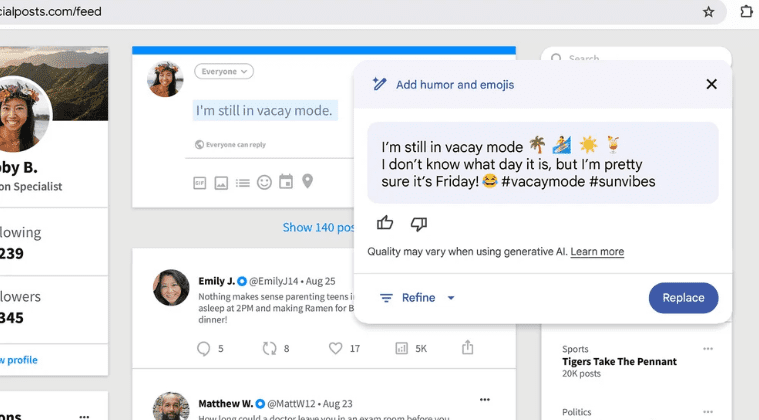
Google AI in action, serving as a writing assistant
AI wallpaper generator
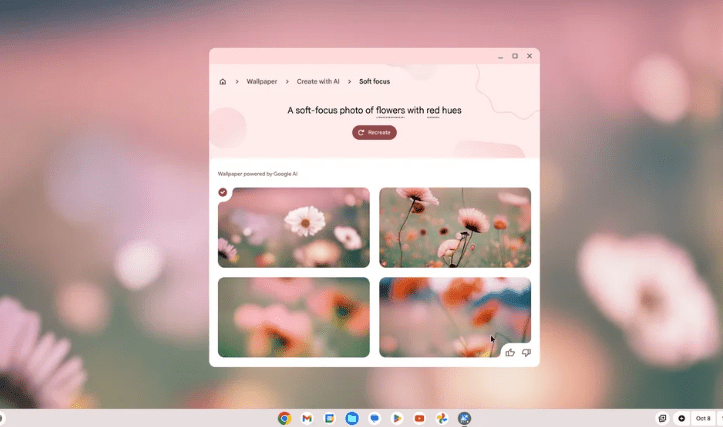
AI wallpaper creator in Chromebook Plus
One more functionality that the company looks to be introducing to Chromebook Plus is an AI-driven wallpaper generator that will create backgrounds for you on demand. By giving the AI text prompts, you can get any wallpaper you want, which is also high quality.
For instance, asking your Chromebook Plus to generate a wallpaper that features astronauts surfing in space seems downright ridiculous at the moment. Still, in 2024, this, along with much wilder iterations, will be a reality.
Generative AI backgrounds for video calls
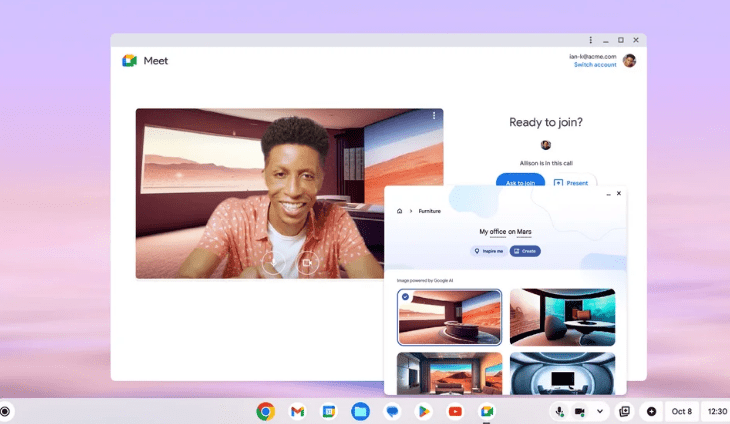
Personalized video call backgrounds
Video calls have received a lot of love in Chromebook Plus. Presumably, next year, Google will implement a feature in ChromeOS that will make it possible to personalize your video conferencing backgrounds using AI via text prompts, just like how you’ll set AI-powered wallpapers in the future.
Wrapping up – Chromebook Plus is an exciting new chapter in ChromeOS’ life
ChromeOS traces its initial release back to 2011; by those terms, Chromebooks have been around for an incredible 12 years. In this period, Chromebooks have seen admirable growth, taking their software capacity to new heights by onboarding Google Play and Linux and bringing ChromeOS Flex in to support worn-out Macs and Windows PCs.
Chromebook Plus, therefore, marks the next chapter in this operating system’s life—a highly promising one. We’ve got next-level features, such as AI-fueled writing assistance, photo editing, and background alterations, coming in next year, all the while being able to pick up a device and work with it just like that after spotting the “Plus” label on it.
Let us know what you think of Chromebook Plus in the comments section ahead. As always, Chrome Ready wishes you good luck!
